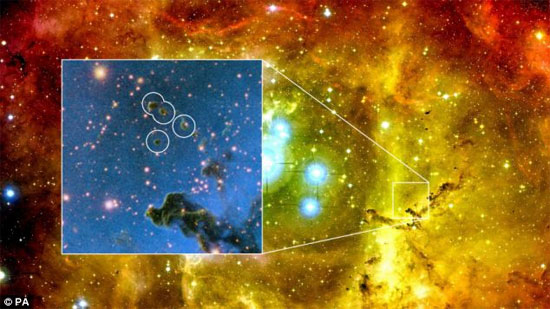Mysterious decoding of
Scientists believe that they have solved the mystery of why some planets exist in the universe without orbiting any star's orbit.
Astronomers from Sweden and Finland say that "wild" planets, without stars, can form from tiny, cold dust clouds in space. Research shows that our galaxy alone can survive up to 200 billion free floating planets.
So far, it has been suggested that such "orphaned" planets must be fired from their solar system. However, the latest observations show that the possibility of some of these free floating planets has formed itself.

The Rosette Nebula contains many globulette clouds (small images) that form the "bastard" planets.(Photo: PA)
The conclusion was drawn when astronomers used multiple telescopes to observe the Rosette nebula, a giant cloud of gas and dust, 4,600 light-years from Earth in the constellation Unicorn (Monoceros). The Rosette Nebula is home to more than 100 clouds of unusual planets, called "globulette" . Each globulette cloud has a diameter less than 50 times the distance from the Sun to Neptune.
Dr Carina Persson from Chalmers University of Technology in Gothenburg, Sweden, said: "We found that the globulette clouds are very dense and compact. Many of them have extremely dense cores. It is implied that many clouds may collapse because of their weight and form free floating planets ".
According to research co-author - Minja Makela of the University of Helsinki (Finland), small, round clouds (globulette) broke off from towering dust and gas columns, which were formed by intense radiation from the throne young stars. They have been accelerated to 80,000 km / h to escape the nebula center thanks to the pressure from the radiation of these hot stars.
The team believes, millions of nebulae like Rosette have appeared and disappeared in the Milky Way's long history. Many nebulae may have produced "wild" planets in the universe.
- Uncover mysterious figures in China
- Decoding alien signals 40 years ago
- Mysterious decoding student used to be an astronomer
- Decode the premonition from the 9 most frequent dreams of man
- Decode the content of the 800-year-old character
- Answer the mysterious structure in the Amazon forest
- Decode cheap DNA
- Mysterious decoding of green light on the Gulf of Thailand
- Mysterious decoding of strange ice holes constantly appearing in Antarctica for decades
- Hell hole in Russia Bermuda triangle decoding
- New DNA technology decodes mysterious deaths
- 10 spooky phenomena under a scientific perspective
 Van Allen's belt and evidence that the Apollo 11 mission to the Moon was myth
Van Allen's belt and evidence that the Apollo 11 mission to the Moon was myth The levels of civilization in the universe (Kardashev scale)
The levels of civilization in the universe (Kardashev scale) Today Mars, the sun and the Earth are aligned
Today Mars, the sun and the Earth are aligned The Amazon owner announced a secret plan to build a space base for thousands of people
The Amazon owner announced a secret plan to build a space base for thousands of people